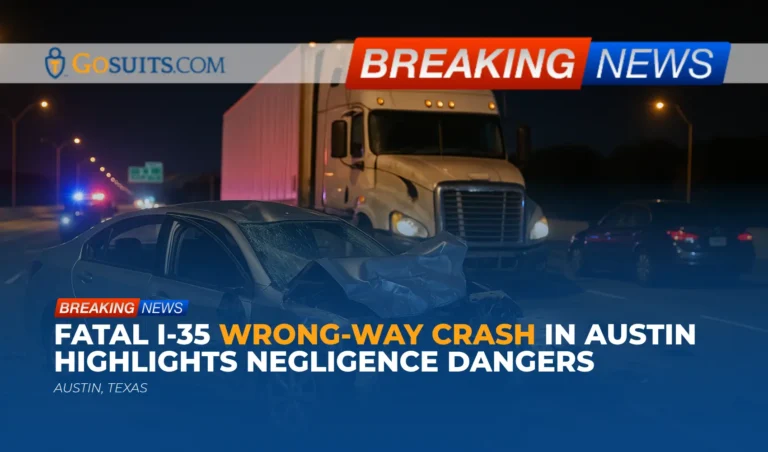A recent, tragic wrong-way collision on Interstate 35 in north Austin serves as a stark reminder of the potential for devastating consequences resulting from negligent driving. The incident, which occurred in the early hours of September 18th, claimed the life of a 23-year-old driver and has prompted reflection on road safety and legal recourse for those affected by such incidents.
Incident Overview
According to the Austin Police Department, the collision took place at approximately 2:16 a.m. in the 12300 block of northbound I-35 near Tech Ridge Boulevard. A 23-year-old, later identified as Victor Lamar Evans II, was driving a sedan southbound in the northbound lanes when he collided head-on with an 18-wheeler. A second sedan was also involved in the collision. The young driver was pronounced dead at the scene. Fortunately, no other injuries were reported.
The incident has been recorded as Austin’s 73rd fatal crash of 2025, resulting in 76 deaths. Authorities are urging anyone with information about the crash to contact investigators at 512-974-8111 or submit anonymous tips through Capital Area Crime Stoppers.
Legal Ramifications and Personal Injury Claims
While details surrounding the circumstances that led to the wrong-way driving are still under investigation, this type of incident often raises significant legal questions, particularly concerning liability and the rights of any potential surviving victims. In scenarios involving a fatal collision, the deceased’s family may have grounds to file a wrongful death claim.
A wrongful death claim is a civil action brought against a person or entity whose negligence, recklessness, or intentional act caused the death of another person. The purpose of a wrongful death claim is to compensate the deceased’s survivors for their losses, which may include:
- Loss of financial support: This includes the income that the deceased would have earned over their lifetime.
- Loss of companionship: This refers to the emotional support, love, and guidance that the deceased provided to their family members.
- Funeral and burial expenses: The costs associated with the deceased’s funeral and burial can be significant and are recoverable in a wrongful death claim.
- Pain and suffering: In some jurisdictions, family members may be able to recover damages for their emotional distress and grief.
In the case of a wrong-way collision, the primary focus of a personal injury claim is determining the cause of the incident. Establishing liability requires a thorough investigation, often involving:
- Police reports: The official police report provides a detailed account of the accident, including witness statements and the investigating officer’s observations.
- Accident reconstruction: Experts in accident reconstruction may be called upon to analyze the scene, vehicle damage, and other evidence to determine how the accident occurred.
- Witness testimony: Eyewitnesses can provide valuable information about the events leading up to the collision.
- Driving records: A review of the drivers’ records can reveal any previous traffic violations or other red flags.
- Toxicology reports: Toxicology tests can determine whether any of the drivers were under the influence of alcohol or drugs at the time of the accident.

Factors that Could Contribute to Wrong-Way Driving
Several factors can contribute to wrong-way driving incidents, including:
- Impairment: Alcohol or drug use is a significant factor in many wrong-way collisions.
- Distraction: Driver distraction, such as texting or using a cell phone, can cause a driver to lose awareness of their surroundings and enter the wrong lane of traffic.
- Fatigue: Drowsy driving can impair judgment and reaction time, increasing the risk of a wrong-way collision.
- Confusion: In unfamiliar areas or during periods of low visibility, drivers may become disoriented and mistakenly enter the wrong lane of traffic.
- Inadequate signage: Poorly designed or maintained signage can contribute to driver confusion and increase the risk of wrong-way driving.
Importance of Safety and Prevention
This tragic incident underscores the importance of safe driving practices and the need for heightened awareness on our roadways. Preventing wrong-way collisions requires a multi-faceted approach, including:
- Strict enforcement of drunk driving laws: Law enforcement agencies must continue to prioritize the detection and apprehension of impaired drivers.
- Public awareness campaigns: Educating the public about the dangers of drunk driving, distracted driving, and drowsy driving can help to change behavior and reduce the incidence of wrong-way collisions.
- Improved roadway design: Highway engineers can implement design features that make it more difficult for drivers to enter the wrong lane of traffic, such as median barriers and rumble strips.
- Enhanced signage: Clear and conspicuous signage can help to guide drivers and prevent them from entering the wrong lane of traffic.

Commentary from Gosuits Austin, Texas Personal Injury Attorney
The fatal wrong-way collision on I-35 is a deeply saddening event, and our hearts go out to all those affected. These incidents highlight the potentially devastating consequences of negligence on our roads. Wrong-way collisions often result in severe injuries or fatalities, leaving victims and their families facing immense emotional and financial burdens. From a legal perspective, these cases require a thorough investigation to determine the cause of the accident and to identify all parties who may be held liable. This may include not only the at-fault driver but also, in some circumstances, other entities responsible for roadway design or maintenance. It is essential for anyone impacted by such a tragedy to understand their rights and to seek experienced legal representation to navigate the complexities of the legal process. We are committed to providing compassionate and skilled legal guidance to those who have been injured or lost loved ones in similar incidents.






